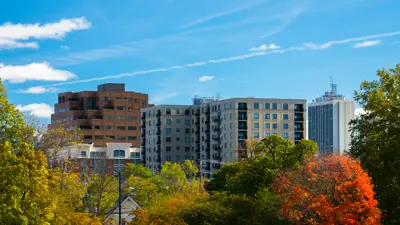Upgrades like air sealing and insulation can reduce exposure to indoor and outdoor pollutants, moisture, mold, and mildew. Replacing methane gas-burning appliances with electric models cuts down on indoor air pollutants linked to respiratory issues for cleaner, safer air.
Looking for help?
For landlords, the Landlord Resource Hub offers compliance guidance and up to $20,000+ in financial assistance, plus free tools to meet Green Rental Housing requirements.
If you’re a renter, check out our tips to lower your energy bills now.
Green Rental Housing is better for your health and comfort, our environment, and your wallet – whether you’re a renter or a landlord
Green Rental Housing is part of all rental property inspections starting on Jan. 6, 2026 (compliance details below) and helps all of Ann Arbor:
- Renters: Enjoy a higher quality of life and lower utility bills, with healthier indoor air and more comfortable room temperatures.
- Landlords: Stay competitive and save money with properties that are easier to maintain and more desirable. You can get extensive rebates and tax credits, simplifying upgrades and future-proofing your investments.
- Everyone: Help us all achieve A2ZERO, our community’s plan to equitably reach carbon neutrality by 2030.
Why Green Rental Housing Matters
- About 55% of Ann Arbor’s residents are renters. Many rental units are well-maintained, comfortable, and energy-efficient. But some older rental units were built before modern building codes and haven’t been updated.
- Renters in inefficient homes often face higher energy bills, drafty or uncomfortable rooms, and even health issues from emissions, moisture, and mold.
- The Green Rental Housing Ordinance sets minimum standards and helps landlords achieve them – so tenants have a place not just to live, but to thrive as we work together toward A2ZERO, community-wide carbon neutrality by 2030.
Benefits of Green Rental Housing
Green Rental Housing isn’t just another regulation – it’s about tangible improvements in daily life and long-term savings:
Well-insulated, energy-efficient units maintain consistent, comfortable temperatures year-round – and boost resilience during power outages and winter storms. They avoid drafts and cold spots in winter and overheating in summer. Stable temperatures, lower energy bills, and cleaner air decrease stress – and support better physical and mental health.
Efficient units use less energy, saving money 24/7. Improvements like air sealing and insulation keep heated or cooled air where it belongs: inside the home. And upgraded appliances like heat pumps or other ENERGY STAR devices also use less power – minimizing monthly utility costs even if electric or gas rates rise.
Buildings produce nearly 70% of Ann Arbor’s greenhouse gas emissions, and boosting rental efficiency is a big opportunity to cut pollution and bring us closer to A2ZERO by 2030.
Helps Landlords Stay Competitive
Healthier, comfier, more efficient units mean happier tenants who are likely to stay longer, recommend your property to friends, and leave positive reviews. That means lower turnover and vacancies. And Ann Arbor’s Office of Sustainability and Innovation provides expert guidance and can connect you with rebates, grants, and tax credits – boosting the ROI on any upgrades you make.
How to Comply
Landlords must do one of the following before their next rental inspection (starting with inspections on Jan. 6, 2026):
Option A – Home Energy Rating System (HERS) Score
|
Option B – Green Rental Housing Checklist
|
Both pathways are part of the City’s existing rental inspection program, following normal inspection procedures and schedules. Many properties may already meet these standards with minor or no adjustments.
Check Out These Time- and Money-Saving Resources:
Landlord Resources
|
Renter Resources
|
Learn More About Green Rental Housing
Key Documents and Links
- Green Rental Housing FAQ: Our in-depth guide is updated regularly and answers common concerns from landlords and tenants. (Topics include technical standards, cost questions, financial and technical assistance, compliance timelines, and more.)
- The Green Rental Housing Ordinance Text was passed by the City Council on June 16, 2025.
- Program Regulations include rules and definitions for implementing the ordinance.
- Green Rental Housing Checklist includes efficiency measures and actions that help landlords achieve compliance, with instructions.
- The Green Rental Housing Attestation form will be used to demonstrate which actions from the checklist are present in the unit.
- Checklist Methodology covers how point values were determined (including modeled emissions or energy reductions, where applicable).
For a one-stop guide to rebates, funding, compliance, and planning tools, visit the Landlord Resource Hub.
Questions and Contact Info
We’ve curated the best of hundreds of hours of discussions with landlords and tenants and compiled them in our regularly updated Green Rental Housing FAQ – it’s a great first stop.
If you still need more information or want to share your feedback, please reach out to: GreenRentalHousing@a2gov.org.

